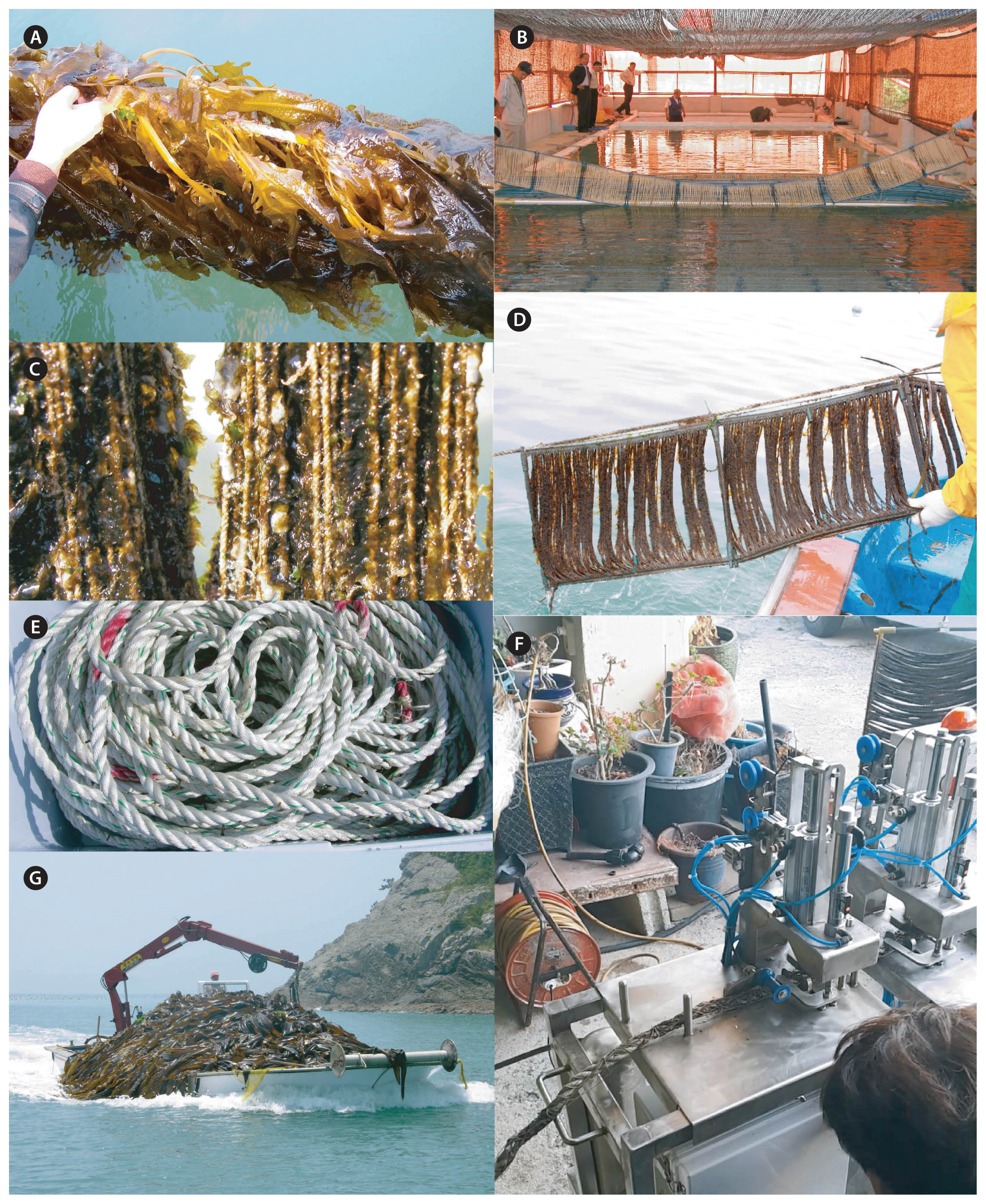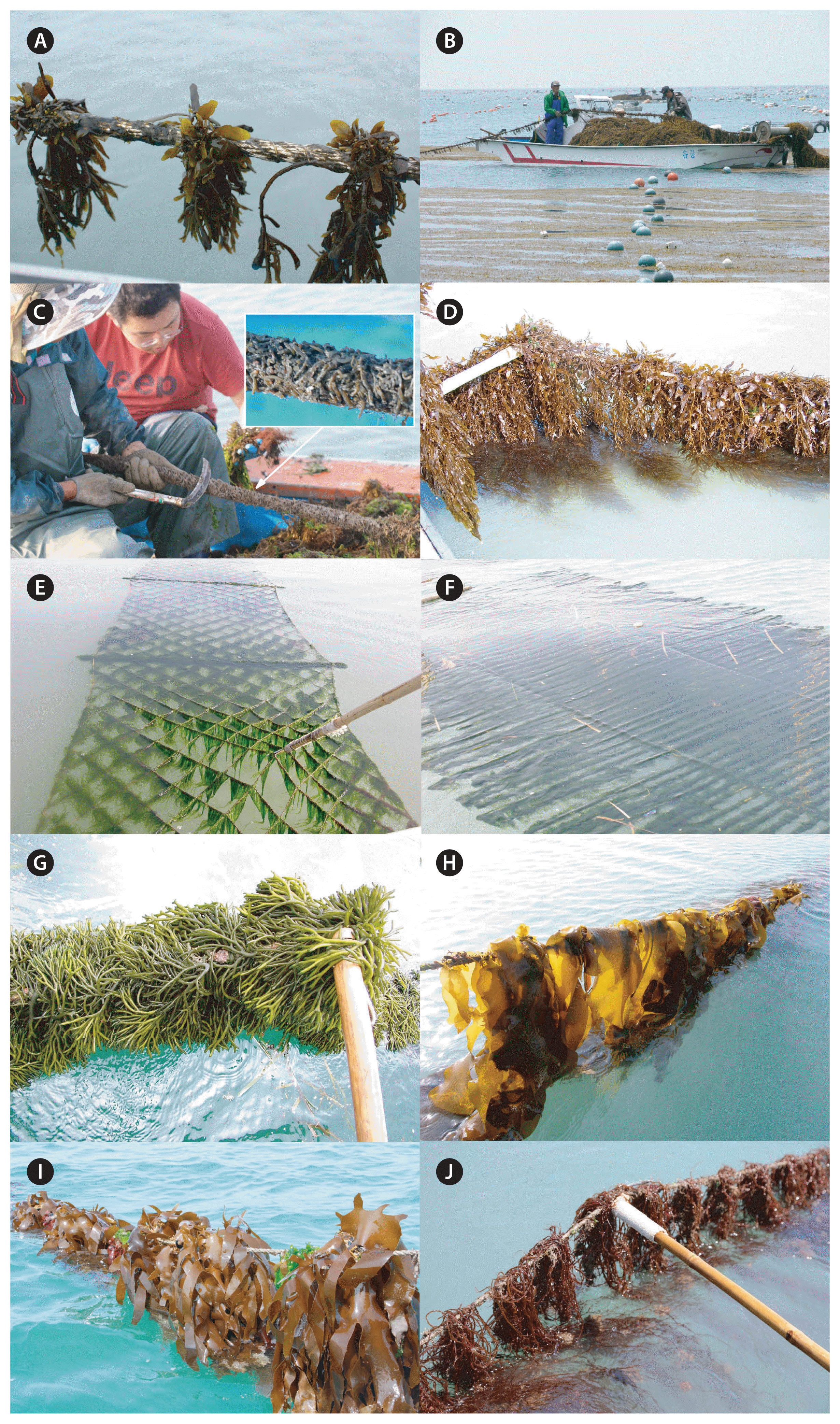Aquatic Plant Variety Center, National Institute of Fisheries Science. 2019. List of registration seaweed cultivars, Available from
http://nifs.go.kr/apvc/index.ap
. Accessed Aug 30, 2019
Bae, SH 1991. The origin and development process of laver culture industry in Korea. 1. Laver culture history till the end of Chosun dynasty. Bull Korean Fish Soc. 24:153–166.
Barbier, M, Charrier, B, Araujo, R, Holdt, SL, Jacquemin, B & Rebours, C 2019. Phycomorph European guidelines for a sustainable aquaculture of seaweeds. European Cooperation in Science and Technology, Nice, 194 pp.
Chang, JW & Geon, SH 1970. Studies on the culture of Laminaria. (1) On the transplantation of tangle Laminaria religiosa Miyabe in temperate zone (the coast of Ilsan-Dong, Ulsan city). Bull Fish Res Dev Agency. 5:63–75.
Choi, HS, Choi, KH & Rhew, TH 2000. Simple and rapid isolation of plasmids from Porphyra tenera
. Algae. 15:133–136.
Choi, S, Hwang, MS, Im, S, Kim, N, Jeong, W, Park, E, Gong, Y & Choi, D-W 2013. Transcriptome sequencing and comparative analysis of the gametophyte thalli of
Pyropia tenera under normal and high temperature conditions. J Appl Phycol. 25:1237–1246.

Chung, MK 1937. Laver of Chosun. Fish Chosun. 144:1–4.
Food and Agriculture Organization of the United Nations. 2017. Fisheries and aquaculture statistics, Available from:
http://www.fao.org/fishery/en
. Accessed Aug 30, 2019
Food and Agriculture Organization of the United Nations. 2018. The state of world fisheries and aquaculture 2018. Meeting the sustainable development goals. Food and Agriculture Organization of the United Nations, Rome, 227 pp.
Hong, YK, Sohn, CH & Chang, JW 1989. Genetic improvement for the low salinity-tolerant Porphyra sp. by cell culture technique. I. Tissue culture of Porphyra yezoensis forma narawaensis
. J Aquac. 2:1–7.
Hwang, EK, Amano, H & Park, CS 2008a. Assessment of the nutritional value of
Capsosiphon fulvescens (Chlorophyta): developing a new species of marine macroalgae for cultivation in Korea. J Appl Phycol. 20:147–151.

Hwang, EK, Baek, JM & Park, CS 2007. Assessment of optimal depth and photo irradiance for cultivation of the brown alga,
Sargassum fulvellum (Turner) C. Agardh J Appl Phycol. 19:787–793.

Hwang, EK, Baek, JM & Park, CS 2008b. Cultivation of the green alga,
Codium fragile (Suringar) Hariot, by artificial seed production in Korea. J Appl Phycol. 20:469–475.

Hwang, EK, Baek, JM & Park, CS 2009. The mass cultivation of
Ecklonia stolonifera Okamura as a summer feed for the abalone industry in Korea. J Appl Phycol. 21:585–590.

Hwang, EK, Cho, YC & Sohn, CH 1999. Reuse of holdfasts in Hizikia cultivation. J Korean Fish Soc. 32:112–116.
Hwang, EK, Gong, YG, Hwang, I, Park, E & Park, CS 2013. Cultivation of the two perennial brown algae
Ecklonia cava and
E. stolonifera for abalone feeds in Korea. J Appl Phycol. 25:825–829.

Hwang, EK, Gong, YG & Park, CS 2011. Cultivation of a brown alga,
Undariopsis peterseniana (Kjellman) Miyabe and Okamura, as a warm-temperature species by artificial seed production in Korea. J Appl Phycol. 23:449–455.

Hwang, EK, Gong, YG & Park, CS 2012. Cultivation of a hybrid of free-living gametophytes between
Undariopsis peterseniana and
Undaria pinnatifida: morphological aspects and cultivation period. J Appl Phycol. 24:401–408.

Hwang, EK, Ha, DS & Park, CS 2017. Strain selection and initiation timing influence the cultivation period of
Saccharina japonica and their impact on the abalone feed industry in Korea. J Appl Phycol. 29:2297–2305.

Hwang, EK, Hwang, IK, Park, EJ, Gong, YG & Park, CS 2014a. Development and cultivation of F
2 hybrid between
Undariopsis peterseniana and
Undaria pinnatifida for abalone feed and commercial mariculture in Korea. J Appl Phycol. 26:747–752.

Hwang, EK, Kim, CH & Sohn, CH 1994a. Callus-like formation and differentiation in Hizikia fusiformis (Harvey) Okamura. Korean J Phycol. 9:77–83.
Hwang, EK, Liu, F, Lee, KH, Ha, DS & Park, CS 2018a. Comparison of the cultivation performance between Korean (Sugwawon No. 301) and Chinese strains (Huangguan No. 1) of kelp
Saccharina japonica in an aquaculture farm in Korea. Algae. 33:101–108.

Hwang, EK, Park, CS & Sohn, CH 1994b. Effects of light intensity and temperature on regeneration, differentiation and receptacle formation of Hizikia fusiformis (Harvey) Okamura. Korean J Phycol. 9:85–93.
Hwang, EK, Yi, YH, Shin, WJ & Sohn, CH 2003. Growth and maturation of a green alga, Capsosiphone fulvescens, as a new candidate for seaweed cultivation in Korea. In : Champman RO, Anderson RJ, Vreeland VJ, Davison IR, editors Seventeenth Int Seaweed Symp. Oxford University Press, Oxford, 59–64.
Hwang, EK, Yotsukura, N, Pang, SJ, Su, L & Shan, TF 2019. Seaweed breeding programs and progress in eastern Asian countries. Phycologia. 58:484–495.

Hwang, IK, Kim, S-O, Hwang, MS, Park, E-J, Ha, D-S & Lee, S-R 2018b. Intraspecific variation of gene structure in the mitochondrial large subunit ribosomal RNA and cytochrome c oxidase subunit 1 of
Pyropia yezoensis (Bangiales, Rhodophyta). Algae. 33:49–54.

Hwang, MS, Kim, S-M, Ha, D-S, Baek, JM, Kim, H-S & Choi, H-G 2005. DNA sequences and identification of
Porphyra cultivated by natural seeding on the southwest coast of Korea. Algae. 20:183–196.

Hwang, MS, Kim, S, Ha, D, Lee, JE & Lee, S-R 2014b. Complete mitochondrial genome sequence of
Pyropia yezoensis (Bangiales, Rhodophyta) from Korea. Plant Biotechnol Rep. 8:221–227.

Hwang, MS, Kim, S, Lee, Y, Park, E, Kim, S, Ha, D, Gong, YG, Baek, J & Choi, H-G 2010. Isolation and characterization of pure lines of pigmentation and morphological mutants in Porphyra tenera Kjellman (Bangiales, Rhodophyta). Korean J Fish Aquat Sci. 43:495–502.
Hwang, MS & Lee, IK 2001. Taxonomy of the genus Porphyra (Bangiales, Rhodophyta) from Korea. Algae. 16:233–273.
Jin, L, Kim, M, Choi, J, Cho, J, Jin, H & Hong, Y-K 2000. Morphology and sequence analysis of nuclear 18S rDNA from the summer strain of Porphyra suborbiculata (Rhodophyta) in Korea. J Korean Fish Soc. 33:489–495.
Kang, JW 1966. On the geographical distribution of marine algae in Korea. Bull Pusan Fish Coll. 7:1–136.
Kang, JW 1972. Species of cultivated Porphyra in Korea. In : Nisizawa K, editor Proc 7th Int Seaweed Symp Univ. Tokyo Press, Tokyo, 108–110.
Kang, JW & Koh, N 1977. Algal mariculture. Taehwa Publ. Co, Busan, Korea, 294 pp.
Kim, E, Park, H, Jung, Y, Choi, D, Jeong, W, Park, H, Hwang, MS, Park, E & Gong, YG 2011. Identification of the high-temperature response genes from
Porphyra seriata (Rhodophyta) expression sequence tags and enhancement of heat tolerance of
Chlamydomonas (Chlorophyta) by expression of the
Porphyra HTR2 gene. J Phycol. 47:821–828.

Kim, H-S & Kim, S-M 2011. Algal flora of Korea. 4(1):Primitive red algae. National Institute of Biological Resources, Incheon, 138 pp.
Kim, NG 2001. Physiological study on the hybrid by interspecific crossing between Porphyra pseudolinearis and P. dentata (Bangiales, Rhodophyta), two dioecious species in culture. J Aquac. 13:353–357.
Kim, S-M, Choi, H-G, Hwang, M-S & Kim, H-S 2018. Biogeographic pattern of four endemic
Pyropia from the east coast of Korea, including a new species,
Pyropia retorta (Bangiaceae, Rhodophyta). Algae. 33:55–68.

Lee, H & Choi, J-I 2018. Isolation and characterization of a high-growth-rate strain in
Pyropia yezoensis induced by ethyl methane sulfonate. J Appl Phycol. 30:2513–2522.

Lee, H, Park, E & Choi, J-I 2019. Isolation, morphological characteristics and proteomic profile analysis of thermo-tolerant
Pyropia yezoensis mutant in response to high-temperature stress. Ocean Sci J. 54:65–78.

Lee, I & Kang, JW 1986. A check list of marine algae in Korea. Korean J Phycol. 1:311–325.
Ministry of Oceans and Fisheries. 2018. Fisheries statistics, Available from:
https://portal.fips.go.kr
. Accessed Aug 30, 2019
Oohusa, T 1993. The cultivation of Porphyra “Nori”. In : Ohno M, Chritchley AT, editors Seaweed Cultivation and Marine Ranching. Japan International Cooperation Agency (JICA), Yokosuka, 57–74.
Park, CS & Hwang, EK 2011. An investigation of the relationship between sediment particles size and the development of green algal mats (
Ulva prolifera) on the intertidal flats of Muan, Korea. J Appl Phycol. 23:515–522.

Park, CS & Hwang, EK 2014. Isolation and evaluation of a strain of
Pyropia yezoensis (Bangiales, Rhodophyta) resistant to red rot disease. J Appl Phycol. 26:811–817.

Park, CS & Hwang, EK 2015. Biochemical characterization of
Pyropia yezoensis-AP1 strain accompanies the resistance reaction to the red rot disease pathogen,
Pythium porphyrae
. J Appl Phycol. 27:2149–2156.

Park, C, Choi, K, Soh, E & Koh, H-J 2016. Study on the future development direction of plant variety protection system in Korea. Korean J Breed Sci. 48:11–21.

Shin, J-A 2003. Quality improvement of dried sheets of
Porphyra using recombinant wild-type in
P. yezoensis (Bangiales, Rhodophyta). Algae. 18:95–100.

Shin, J-A, Miura, A & Fu, PF 1997. Hybrid breakdown and breakthrough in interspecific crosses between Porphyra yezoensis and P. tenera
. National History Research, Special Issue. 3:65–70.
Sohn, C-H 1996. Historical review on seaweed cultivation of Korea. Algae. 11:357–364.
Sohn, CH 1998. The seaweed resources of Korea. In : Critchley AT, Masao O, editors Seaweed Resources of the World. Japan International Cooperation Agency, Yokosuka, 15–33.
Sohn, CH 2009. Seaweed cultivation. Dain Communications, Busan, 283 pp.
Sohn, CH & Kain, JM 1989.
Porphyra cultivation in Korea. In : Kain (Jones) JM, Andrews JW, MacGregor BJ, editors Outdoor Seaweed Cultivation. Proc 2nd Workshop of COST 48 Subgroup 1, Port Erin. 106–109.
Yoo, JG 1964. Experiment of PVA net in Porphyra cultivation. Technical Report of National Fisheries Research & Development Agency. National Fisheries Research and Development Agency of Korea, Busan, 36 pp.
Yoon, JT, Cho, YC & Gong, YG 2003. A study on the cultivation of Enteromorpha prolifera (Müller) J. Agardh, Chlorophyta in Korea. J Aquac. 16:44–50.







